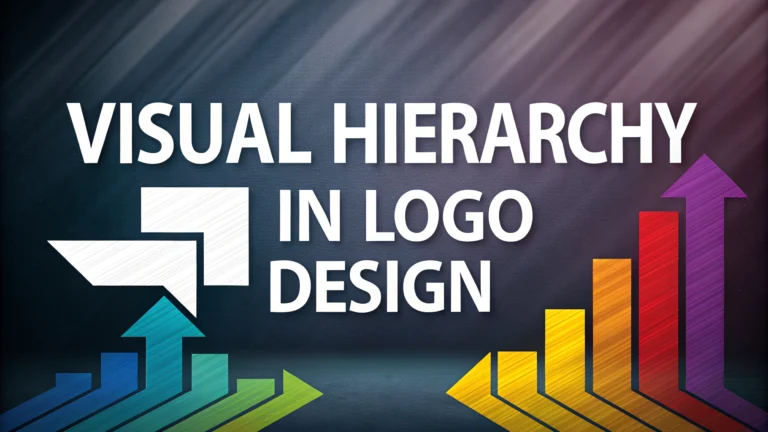A strong visual hierarchy in your logo design helps guide viewers’ eyes and communicate your brand’s message effectively.
Understanding Visual Hierarchy
Visual hierarchy determines which elements of your logo get noticed first and in what order.
Key Elements of Visual Hierarchy
- Size: Larger elements naturally draw more attention
- Color: Bright or contrasting colors stand out
- Position: Central or top elements get noticed first
- Space: White space helps emphasize important elements
- Contrast: Elements that stand out from their surroundings
Practical Tips for Logo Hierarchy
Size Relationships
Scale your logo elements according to their importance – primary elements should be 100% size, secondary elements 60-80%, and tertiary elements 40-60%.
Color Strategy
- Primary brand color: Main logo element
- Secondary colors: Supporting elements
- Neutral colors: Background or minor details
Space Management
Leave enough breathing room between elements – a good rule is maintaining space equal to the height of your primary text.
Common Hierarchy Mistakes to Avoid
- Too many competing elements
- Insufficient contrast between elements
- Overcrowding design elements
- Using too many colors
Testing Your Logo’s Hierarchy
Test your logo at different sizes and in black and white to ensure the hierarchy remains clear.
Quick Testing Methods:
- Squint test: Blur your vision to see which elements stand out
- Distance test: View from 10 feet away
- Mobile screen test: Check visibility on small screens
Professional Tools
- Adobe Illustrator: Industry standard for logo design
- Figma: Collaborative design tool with excellent hierarchy controls
- Sketch: Popular among Mac users for logo design
For professional logo design assistance, consider contacting the American Institute of Graphic Arts (AIGA) at www.aiga.org.
Implementation Strategy
Start with a clear sketch of your hierarchy plan before moving to digital tools. Map out primary, secondary, and tertiary elements deliberately.
Development Phases
- Sketch multiple variations
- Create digital wireframes
- Test different hierarchical arrangements
- Gather feedback from target audience
Responsive Hierarchy
Design your logo’s hierarchy to work across different platforms and sizes while maintaining its visual impact.
Adaptation Guidelines
- Create simplified versions for small sizes
- Maintain recognizable elements in all versions
- Adjust spacing for different formats
Measuring Success
Track how effectively your logo’s hierarchy communicates across various applications and audiences.
Success Indicators
- Brand recognition speed
- Message clarity
- Versatility across mediums
- Stakeholder feedback
Conclusion
Effective visual hierarchy in logo design requires careful planning, testing, and refinement. Focus on clear communication through size, color, position, and contrast while maintaining simplicity and scalability. Regular testing and adaptation ensure your logo remains effective across all applications.
Final Checklist
- Verify hierarchy at all sizes
- Ensure consistent brand message
- Confirm accessibility standards
- Document hierarchy guidelines for future use
FAQs
- What is visual hierarchy in logo design and why is it important?
Visual hierarchy is the arrangement of elements in a logo based on their importance, guiding viewers’ attention in a specific order. It’s crucial because it helps communicate the brand message effectively and ensures the most important elements are noticed first. - What are the key principles of visual hierarchy in logo design?
The key principles include size contrast, color hierarchy, spacing, typography weight, positioning, and the use of negative space. These elements work together to create a clear visual path for the viewer’s eye. - How does size affect visual hierarchy in logos?
Larger elements naturally draw more attention and are perceived as more important. Varying sizes of elements in a logo helps establish dominance and creates a clear order of importance in the design. - What role does color play in creating visual hierarchy?
Color creates contrast and emphasis, with brighter or more saturated colors drawing more attention than muted ones. Strategic color use can direct focus to specific elements and create depth in the logo design. - How does typography contribute to visual hierarchy in logos?
Typography hierarchy is created through variations in font weight, size, style, and spacing. Bolder or larger text typically indicates primary information, while smaller or lighter text suggests secondary importance. - What is the significance of spacing in logo hierarchy?
Spacing, or white space, helps separate elements and create breathing room. Proper spacing can emphasize certain elements, improve readability, and create a more balanced, professional appearance. - How can contrast be used effectively in logo hierarchy?
Contrast can be achieved through differences in size, color, shape, or texture. Strong contrast helps distinguish between elements and creates clear focal points within the logo design. - What is the rule of thirds in logo hierarchy?
The rule of thirds divides the logo space into a 3×3 grid, with key elements placed along these lines or at their intersections to create natural focus points and balance. - How many hierarchical levels should a logo have?
Most effective logos contain 2-3 levels of hierarchy. Too many levels can create confusion and complexity, while too few may not effectively communicate the brand message. - How does visual hierarchy affect logo scalability?
Good visual hierarchy ensures the logo remains effective at different sizes. The most important elements should remain clearly visible and recognizable when scaled down for various applications.








